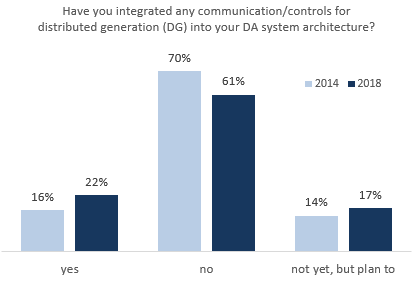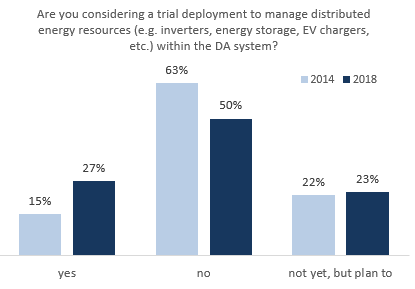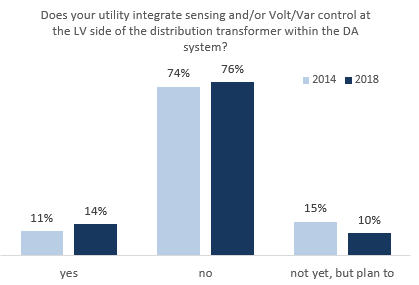More interim findings from a Newton-Evans study currently underway, “North American Distribution Automation Market Assessment & Outlook 2018-2020,” suggest a trend of gradual integration of communications and control for the management of distributed generation (DG) and distributed energy resources (DERs) among North American electric Utilities. The growth of DG and DERs raises a number of challenges for electric utilities and asset owners who might need to integrate these new resources into their existing distribution automation systems. Here are a few mid-study observations from the survey responses that have been received so far:
Integration of Distributed Generation Communication and Control Into Distribution Automation System Architecture
In 2014, 16% of utility personnel surveyed said they had already integrated communications and/or controls for DG into their DA system, while 70% said they had not. Fourteen percent of utilities surveyed had plans to integrate DG comms/controls by 2017. The 2018 survey shows a slight increase among the sample in the adoption of DG communication and control within the DA system: 22% of utilities surveyed in this study so far have indicated that they are integrating DG into DA, while 61% said they have not. Seventeen percent of respondents said they have plans to integrate more DG controls into DA by 2020. (See fig. a)
 Fig. A
Fig. A
Are you considering a trial deployment to manage distributed energy resources (e.g. inverters, energy storage, EV chargers, etc.) within the DA system?
The percent of utilities surveyed who are considereing a trial deployment to manage DERs has also increased somewhat over the 2014 survey results. In 2014, 15% of those surveyed said they were considering this, while the current 2018 study shows that 27% of utilities surveyed are considering a trial deployment to manage DERs, 23% are planning to consider this by 2020, and half have no plans to do this.
 Fig. B
Fig. B
Integration of Sensing and/or Volt/VAR Control at the LV Side of the Distribution Transformer Within the DA System
There was no apparent change in the percent of utilities surveyed who integrate sensing or Volt/VAR control at the LV side of the transformer between what we observed in 2014 and this year’s study; only 14% of this year’s survey respondents so far have said they use sensing and/or VVC in this situation. In 2014, 11% said they use sensing/VVC at the low side of the transformer.
 Fig. C
Fig. C
This 2018 DA Market Study will be sold individually and also as part of a report bundle on DA that includes: 1) the “Overview of the 2017-2020 U.S. Transmission and Distribution Equipment Market: Distribution Automation Series (Complete Set of 9 top-line reports)” and 2) a 40-slide Power Point deck developed by Chuck Newton titled, “The Role of Advanced DMS/SCADA Software and Systems in Building a Resilient and Reliable Power Distribution Grid.”
Contact us for more information, report samples and pricing information:
info@newton-evans.com
410-465-7316
https://www.newton-evans.com/our-reports/

 summary reviews and highlights from completed studies
summary reviews and highlights from completed studies
